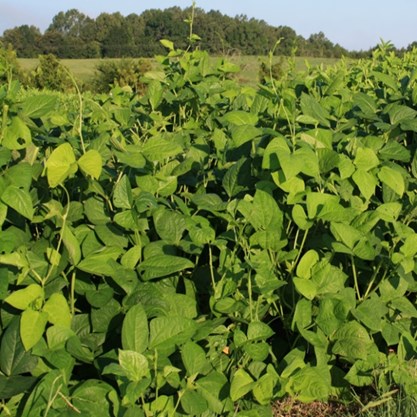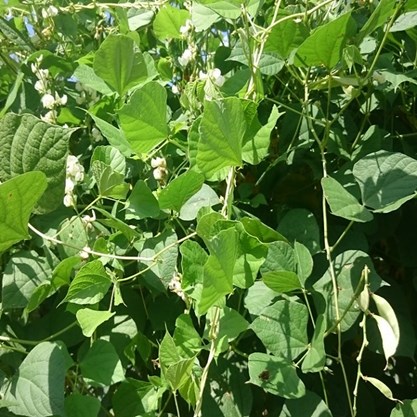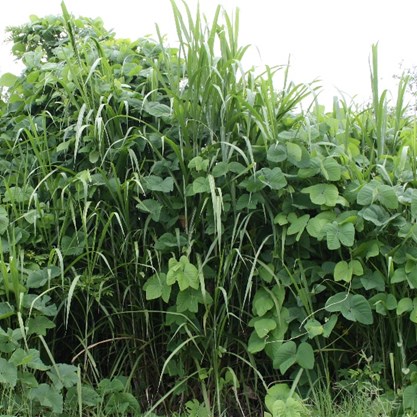Summer Annual Legumes for the Southern USA
There is growing interest in the use of short-season summer annual legumes in grazing systems due to the increase in fertilizer cost. Summer annual legumes can enhance nutritive value while extending the grazing season. These legumes can be used as cover crops for improving soil health benefits such as reduce soil erosion and runoff, increase soil organ-ic matter and improve soil physical properties. Despite these benefits, warm-season annual legumes (WSAL) can have disadvantages such as seed and cost and variability in germination which can impact establishment.
The establishment and management of WSAL depend on climate (precipitation amount and distribution, and extremes of temperature) and the companion grass. Although these legumes can be planted in pure stands, there are advantages in planting grasses with them is the grasses are not so aggressive in the establishment that they severely can reduce leg-ume forage yields. Some of these grasses include crabgrass, sudangrass, pearl millet, forage sorghum, and sorghum x sudangrass hybrids. Usually, these legumes are higher in nitrogen (higher crude protein) and lower in carbon than grass-es. The combination of annual grasses and legumes can provide the benefit of higher biomass, better nutritive value as well as the opportunity to close the canopy and suppress weed competition. To ensure nitrogen fixation of these WSAL make sure that they are inoculated with the proper strain of Rhizobium bacteria (EL Type) at planting to ensure that nitro-gen fixation of these legumes will take place.
Selecting legume species will depend on soil characteristics (drainage, fertility, and pH) and primary use. Legumes are particularly sensitive to pH levels and drainage conditions, so special attention must be given to these characteristics. Legumes may be used for forage (as hay, silage, green chop, or pasture), soil conservation, or wildlife. Some of the WSAL that could be beneficial to grazing systems in the southern USA includes:

Alyce clover (Alysicarpus vaginalis) is a late-growing summer annual legume, but it is not a true clover. It has an erect growth reaching up to 5 feet. Although it will do well on clay soils, it is best adapted to well-drained, sandy soils of the coastal region. Alyce clo-ver is tolerant of moderate soil acidity but does better at pH 6 to 6.5 and it responds phosphorus fertilization. It does not compete well with weeds at the seedling stage. It is very susceptible to root-knot nematodes. Peak biomass production will occur between mid-June and early September. The recommended seeding rate is 15 to 20 pounds per acre at a seeding depth of ¼ to ½ inch. Planting dates range from April 15 (coastal area) to June 15. Biomass yields can range from 2,500 to 3,500 pounds of dry matter per acre. The protein content of alyce clover ranges from 18 to 20 percent. It is recommended to use it as a monoculture instead of planting with companion grasses. Alyce clover can tolerate heaving grazing and it can be grazed when plants reach 12 to 18 inches to a 3 to 4 inches stubble height. It does not cause bloat.

Cowpea (Vigna unguiculata) does well in hot and humid climates. It is also known as blackeye, crowder, and southern pea. Cowpea has a deep taproot system and does well under droughty conditions. It is adapted to a wide range of soils with low fertility (more acid soils). Grows well on clay soils provided they are well-drained. Plants can be sus-ceptible to root diseases. It can be established very easily and can produce high yields. Yields can range from 2500 to 3500 pounds of dry matter per acre with 18 to 24 percent crude protein. Planting depth ranges from1 to 3 inches. It can be drilled at 40 to 60 pounds per acre or broadcast at 60 to 90 pounds per acre. Higher seeding rates are rec-ommended for late summer planting where soil moisture can be limiting. It can be plant-ed from April 15 (Coastal Region) to June 30. Cowpeas does not cause bloat. The plants can grow up to 2 feet tall and they have the ability of climbing when planted with other summer annual grass species. Cowpeas can have moderate regrowth after grazing with rest periods.

Lablab (Lablab purpureus) is not drought tolerant as cowpea. It has a longer growing season than cowpea and it is more frost tolerant under late planting conditions. Lablab is less susceptible to root diseases than cowpea. It is adapted to moderately to well-drained soils with soil pH ranging from 5.0 to 7.5. Although it performs well with low fer-tility, the soil should be amended with the recommended amount of lime and fertilizer (phosphorus and potassium) to ensure plants achieve optimal growth and nutritive value. It can be planted at a depth of 1 to 4 inches. I can be planted from April 15 (Coastal Re-gion) to June 15 at a seeding rate of 15 to 20 pounds per acre. Biomass production can range from 2,000 to 4,000 pounds of dry matter per acre. Lablab will regrow after graz-ing and haying, but they may not grow as fast as the grass component and contribute less than expected. It can crude protein values ranging from 22 to 26 percent crude pro-tein in pastures with good fertility. It does not cause bloat.

Soybean (Glycine max) is a summer legume crop that can be established quickly and can grow 2 to 4 feet tall. Soybean requires a fertile and well-drained soil for best growth. It has a deep taproot system reaching 8 to 12 inches, but it can only withstand short peri-ods of drought. Soybeans can be easily damaged by frost. Soybean planted for grazing should be broadcast or closely drilled at 60 to 90 pounds per acre at a seeding depth of ¾ to 1 inch. It is a good competitor with mixed grasses such as corn, forage sorghum, and sorghum x sudangrass hybrids. Yields can range from 3,000 to 6,000 pounds of dry matter per acre. In a grazing system, it is recommended to use late-maturing varieties to maximize biomass production. Grazing should not start until forage soybean reaches between 28 to 36 inches. Crude protein can range from 15 to 20 percent. Some forage type varieties that are more viney forage types are available with the potential to produce more biomass than traditional soybean varieties.

Velvet bean (Mucuna pruriensvar) is an annual climbing vine that grows aggressively to several feet high. It can be intercropped with summer annual grasses (forage sorghum, pearl millet, and sorghum x sudangrass hybrids). It has suppressing activity of root-knot and reniform nematode activity. Velvet bean tolerates a wide range of pH from 5.5 to 7.2. It is not well adapted to coastal areas due to poor salinity tolerance. It is not adapted to heavy clay soils with poor drainage. It can be planted at a seeding rate of 40 to 60 pounds per acre at a depth of 1.5 to 3 inches. Biomass production ranges from 1,500 to 3,000 pounds per acre. The protein content of velvet bean ranges from 14 to 22 percent. Regrowth of velvet bean depends on grazing management. Some regrowth might be possible if plants are cut before flowering.
Incorporating annual legumes into Mississippi’s forage cropping systems could provide producers with a variety of bene-fits including summer forage, biological N, and improving forage quality of warm-season annual grasses. Several other warm-season annual legumes are available but are not commonly used because of the difficulty in the establishment and the high cost of seed. Mixtures of some of these warm-season annual legumes with summer annual grasses can be planted to optimize the benefits associated with improving biomass and nutritive value during the summer. Mixtures can increase above-ground biomass and consequently can take advantage of the allelopathic potential to suppress weeds.
Upcoming Events
- March 26, 2020—Coastal Plain Experiment Station Beef Cattle Field Day, Newton, MS.
For upcoming forage related events visit: http://forages.pss.msstate.edu/events.html
Cooperative Extension Service • Mississippi State University
Mississippi State University is an equal opportunity institution. Discrimination in university employment, programs or activities based on race, color, ethnicity, sex, pregnancy, religion, national origin, disability, age, sexual orientation, genetic information, status as a U.S. veteran, or any other status protected by applicable law is prohibited.



